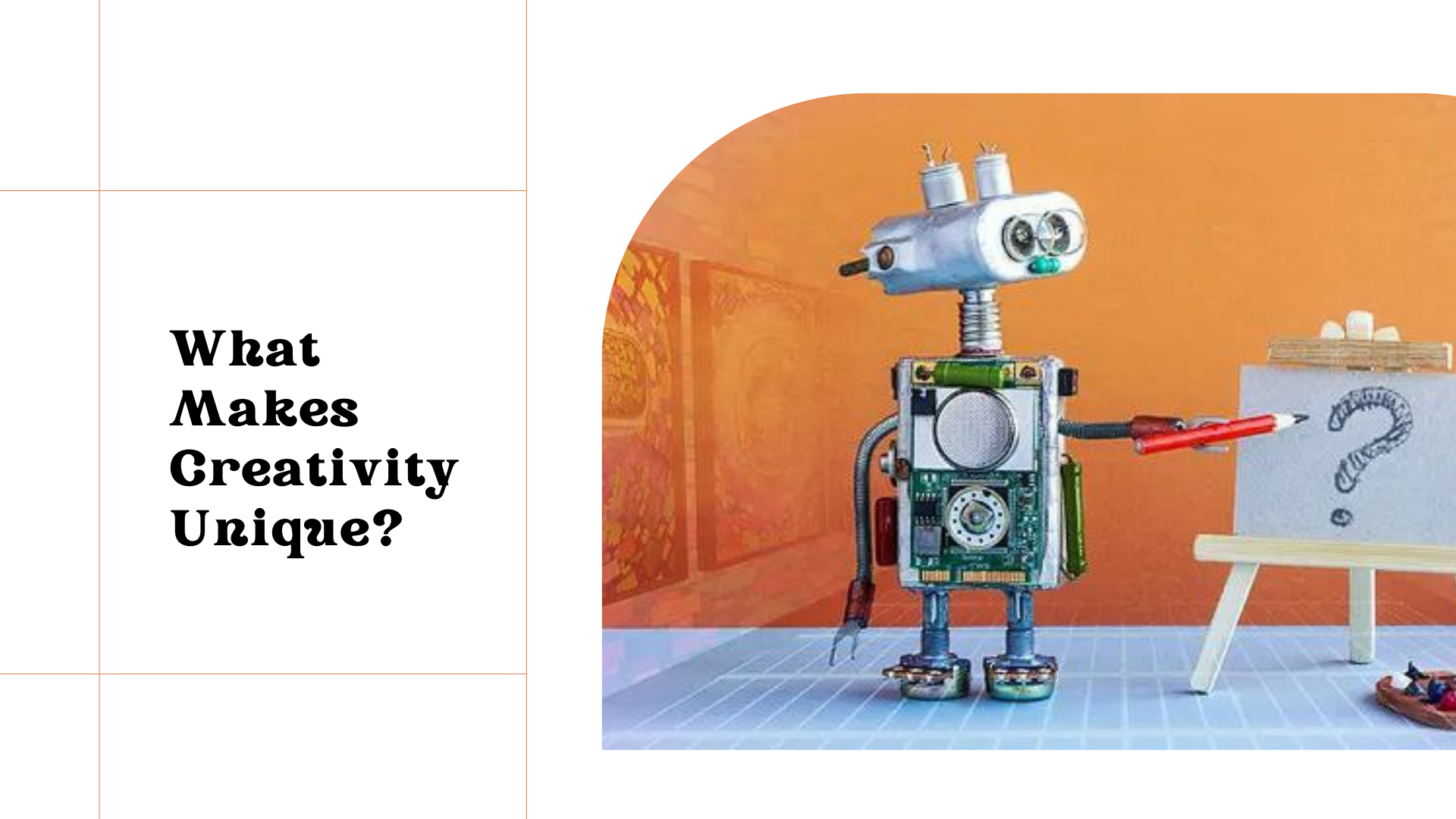Have you ever wondered if a computer or a robot can be genuinely creative? When we think about creativity, we usually picture artists, writers, and musicians coming up with unique ideas and expressions. But with AI technology advancing rapidly, it’s worth asking: Can AI be truly creative, or is it just mimicking human creativity?

What Makes Creativity Special?
Creativity is often seen as something deeply human. It involves original thinking, emotional depth, and the ability to connect ideas in new ways. When we create something, whether it’s a piece of art, a new recipe, or a catchy tune, we’re drawing on our experiences, emotions, and personal perspectives. But how does AI fit into this picture?
Can AI Be Truly Creative, or Is It Simply Replicating Patterns It Has Learned from Existing Data?
As AI technology becomes increasingly sophisticated, it’s worth asking whether AI can be truly creative or if it’s simply mimicking patterns from the data it has processed. This question explores the limits of AI’s creative abilities and whether machines can generate truly original content or just repurpose existing ideas.
Gordon Hirsch, Founder and Managing Attorney at Hirsch Law Group, offers a nuanced perspective on this: “While AI can certainly produce content that seems novel, innovation is more than just making something that hasn’t been seen before. It’s about creating something that pushes boundaries or offers new perspectives. AI can generate content that is technically new, but it’s still based on patterns and data that humans have provided. So, in many ways, it might be more accurate to say AI is an incredible tool for creativity, but it might not be truly ‘innovative’ in the sense that we understand human-driven innovation.” This viewpoint highlights the distinction between creating novelty and achieving true innovation.
Can AI Generate Original Ideas?
In recent years, we’ve seen remarkable progress in AI, especially with tools like ChatGPT and DALL-E. These generative AI models can create visual art, write stories, and even compose music, all thanks to advancements in machine learning and neural networks. But can AI really come up with something truly original? While these tools are great at mixing and matching ideas from the data they’ve been trained on, they aren’t exactly creating from scratch.
Instead, AI tends to rearrange and recombine what it already knows, producing content that feels new but is often just a remix of existing concepts. So, while AI can mimic creativity, it’s not quite the same as the human process of generating completely original ideas. This raises some thought-provoking questions about what creativity means in a world where technology plays an ever-growing role.
Elvis Sun, a Software Engineer at Google and Founder of PressPulse, emphasizes that AI, despite its impressive outputs, operates within the limits of its programming. It rearranges and combines existing data rather than creating something fundamentally new. This view highlights AI’s reliance on pre-existing information rather than generating truly original ideas.
“Huge volumes of text, images, audio, and other kinds of data are trained on by the algorithms artificial intelligence employs. These systems are meant to uncover relationships and trends in the data. From this vantage point, artificial intelligence is merely rearranging and combining already existing elements in a way that humans could find creative inspiration; it is not really creating anything fresh or unique. According to this point of view, artificial intelligence lacks the spark of genuine creativity—usually associated with human characteristics including imagination, emotional expression, and the capacity to transcend expectations of them.”
Julie, a Digital PR Specialist at AI Fire, points out that AI’s creative outputs are based on patterns from its training data. It excels at combining and rearranging existing ideas but doesn’t generate entirely new concepts or insights. This reinforces the notion that AI is a powerful tool but not a true source of originality.
“AI can’t truly be creative in the way humans are. Instead, it works by replicating patterns it has learned from existing data. AI analyzes huge amounts of information and uses that to generate new content, but it’s not coming up with original ideas or thoughts. It’s more like a super-advanced tool that combines and rearranges what it already knows.
For example, when AI writes a story or makes a piece of music, it’s drawing from patterns and examples it has seen before. It can mix things in interesting ways, but it’s not creating something completely new from scratch. So, while AI can produce impressive results, it’s not truly creative—it’s just really good at mimicking and reusing what it’s learned.”
Yasin Arafat, Founder and CEO of DOPPCALL acknowledges that while AI can produce content that seems creative, it’s fundamentally based on existing data patterns. Despite this, AI’s innovative combinations can still inspire human creators and lead to new artistic possibilities.
“While AI can generate content that appears creative, it fundamentally works by analyzing and replicating patterns from the data it has been trained on. This means that AI creativity is more about recombining existing elements in novel ways rather than producing something entirely original. AI doesn’t possess emotions, consciousness, or personal experiences, which are often integral to human creativity. However, AI‘s ability to generate unexpected combinations can still inspire new forms of art and push human creators to think outside the box.”
Guido Graf, Founder of PrivateUpgrades, sees AI as a tool that complements human creativity rather than replacing it. While AI’s lack of emotional depth limits its creative capacity, it can enhance and diversify human creative processes by offering new ideas and perspectives.
“When it comes to the question of whether AI can truly be creative, I believe that AI‘s role is more about enhancing our creativity rather than replacing it. AI operates by recognizing and replicating patterns from existing data, which means it doesn’t create in the same way a human does. It lacks the emotional depth and personal experiences that drive human creativity. However, by using AI as a tool, I can explore new ideas and perspectives that I might not have considered on my own, making my creative process richer and more diverse.”
Artificial Intelligence vs. Human Imagination
When it comes to the battle of creativity between AI and human imagination, the outcome isn’t straightforward. AI systems, such as generative adversarial networks, have shown incredible capabilities in producing creative solutions, from generating stunning visuals in AI art to crafting music and writing. However, these achievements raise the question of whether AI can ever truly replicate human creativity. AI’s creativity is primarily rooted in existing data; it learns patterns and generates new content based on what it has already seen, but does this process equate to true creativity?
While AI can produce work that appears original, it lacks the intuitive leaps, emotional depth, and personal experiences that define human creativity. AI’s creativity is limited by its programming and the data it’s been trained on, making it more of a tool than a creator. Here are some key points to consider:
- Human Creativity Involves Emotion: AI doesn’t experience emotions, which are often at the core of human creativity, influencing art, music, and literature in profound ways.
- Imitation vs. Innovation: AI systems imitate patterns found in data, while human creativity often involves breaking those patterns and thinking outside the box.
- Personal Experience: Human creativity is shaped by individual experiences and cultural influences, something AI can’t replicate.
- AI as a Creative Partner: Rather than seeing AI as a competitor, many believe it can be a powerful tool that enhances human creativity, offering new perspectives and possibilities.
Exploring AI’s Creative Potential
AI’s creative potential is both exciting and challenging. With advancements in artificial intelligence, we now see AI’s ability to generate new ideas and creative work. These systems rely on vast amounts of data, training data, that helps them produce creative outputs. However, the question of Can AI be truly creative like humans remains open.
AI struggles to replicate the depth of human thought and emotion that is essential to true creativity. While a good AI system can create new content, it often lacks the uniquely human touch found in art created by humans. Despite recent advancements in AI, there is still a gap in producing creative outputs that fully capture what makes human art so special.
The creative work generated by AI raises important questions, including concerns about privacy policy and the originality of ideas. While AI can offer many ideas, it’s essential to recognize that creativity, in its truest form, is something deeply rooted in human experience and thought. Whether AI can ever reach that level is a matter of ongoing debate.

Can Technology Replace Human Creativity?
The question of whether technology can replace human creativity is quite interesting. While advanced generative AI models developed by OpenAI can innovate and produce creative outputs, the essence of creativity actually comes from something deeper and unique to humans. AI algorithms, though powerful, are still mostly based on existing data and patterns, making us wonder if Can AI be truly creative like humans.
Creativity is more than just generating novel ideas; it’s about the spark of human imagination that brings something entirely new into the world. AI can generate images from textual prompts or even produce music, but does this really count as creativity? Some say AI can be creative, but others believe that the true definition of creativity is something only a creative person can possess. As AI continues blurring the lines between human and machine creativity, we must think about whether technology can ever fully replace the unique creative skills that only humans have.
How Generative AI Challenges Our Notions of Creativity
AI has really made us rethink what creativity means. Traditionally, creativity is seen as a unique expression of human imagination, something that machine intelligence, no matter how advanced, is deprived of. But with generative models like DALL-E 2, which uses convolutional neural networks to generate images from textual descriptions, the line between human and AI creativity is getting blurred.
AI’s ability to generate ideas and create content forces us to reconsider what true creativity is. While AI can create images, generate new content based on existing data, and even produce original art, it raises questions about whether these creations are as meaningful as those made by human imagination. Some believe that AI can never truly replicate the depth of human ideas, but others see it as a tool that can enhance our creative potential.
- AI can:
- Generate ideas and content quickly.
- Create images and art that were previously unimaginable.
- Use natural language processing to create original text.
- Assist in highly creative projects by offering new perspectives.
- Push the boundaries of what we consider as “original” art in the art world.
In the end, while AI challenges our ideas about creativity, it also opens up new ways for creative expression that were once limited to human capabilities.
How Does AI Balance User Preferences and Creative Innovation?
AI plays a crucial role in creating personalized experiences by analyzing user preferences and tailoring content to match individual tastes. This helps users feel more connected and satisfied with the content they receive. However, balancing this personalization with creative innovation can be challenging.
Gordon Hirsch, shares his insights on this issue: “Finally, balancing user preferences with creative innovation is a core challenge for AI. AI systems can be fine-tuned to optimize for specific user preferences, analyzing past behavior or choices to create tailored experiences. However, this can create tension with true creative exploration. If an AI system is always giving users what they want based on their preferences, it may stifle the kind of innovation that challenges existing ideas and introduces new forms of creativity. There’s a delicate balance that needs to be struck, and it requires thoughtful design and consideration of both user experience and creative freedom.” This perspective highlights the importance of designing AI systems that not only cater to user needs but also allow room for innovation and exploration.
